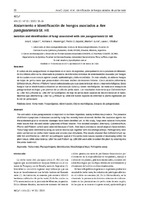Aislamiento e identificación de hongos asociados a Ilex paraguariensis St. Hil.
Isolation and identification of fungi associated with Ilex paraguariensis St. Hil.
Date
2020-06-25Author
López, Ana Clara
Alvarenga, Adriana Elizabet
Zapata, Pedro Darío
Luna, María Flavia
Villalba, Laura Lidia
Metadata
Show full item recordAbstract
El cultivo de Ilex paraguariensis es importante en el norte de Argentina, principalmente en la provincia de Misiones. En los últimos años se ha observado la presencia de diferentes síntomas de enfermedades causadas por hongos de los cuales no se conoce agente causal, epidemiología y daño económico. En este estudio, se aislaron hongos de hojas de yerba mate que presentaban síntomas visibles de lesiones foliares. Cinco aislados (Alternaria, Colletotrichum, Phoma y Pilidium) fueron seleccionados por sus características micro y macromorfológicas. Estos hongos fueron identificados utilizando un microscopio óptico y claves morfológicas. Se realizaron ensayos de patogenicidad en hojas y en plantas de un año de yerba mate. Los resultados mostraron que Colletotrichum sp. LBM 183 y Phoma sp. LBM 207 son patógenos de hoja de yerba mate capaces de desarrollarse en el tejido. Mientras que Alternaria sp. LBM 186 y Pilidium sp. LBM 208 fueron capaces de enfermar la planta ingresando por la raíz de yerba mate. The cultivation of Ilex paraguariensis is important in northern Argentina, mainly in Misiones province. The presence of different symptoms of diseases caused by fungi has recently been observed. Neither the causative agents nor the epidemiological or economic damages have been identified yet. In this study, fungi were isolated from yerba mate leaves that showed visible symptoms of foliar lesions. Five isolated samples: Alternaria, Colletotrichum,
Phoma and Pilidium; which were selected because of both, their micro and macro morphological characteristics.
These fungi were identified by using an optical microscope together with morphological keys. Pathogenicity tests
were carried out on yerba mate leaves and on one-year-old plants. The results showed that Colletotrichum sp.
LBM 183 and Phoma sp. LBM 207 are pathogens typical of the yerba mate leaves capable of developing within the
plant tissue, while Alternaria sp. LBM 186 and Pilidium sp. LBM 208 were able to sicken the plant by entering into
the yerba mate root.
URI
https://hdl.handle.net/20.500.12219/2597https://doi.org/10.36995/j.recyt.2020.33.003
https://www.fceqyn.unam.edu.ar/recyt/index.php/recyt/article/view/500
Collections
The following license files are associated with this item:




